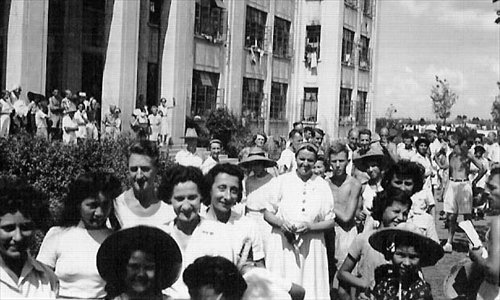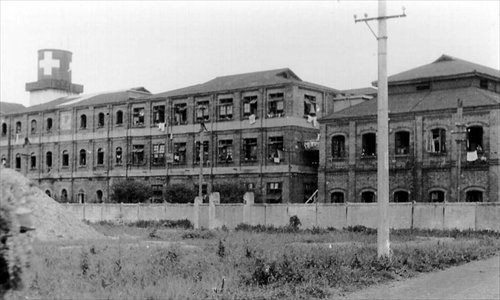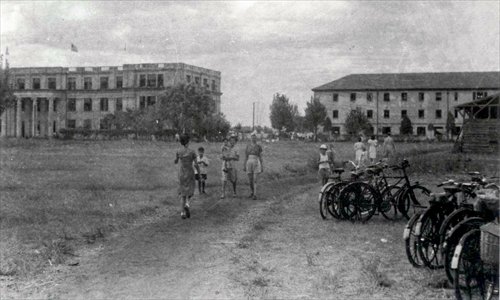Shanghai's war prisoners

Scenes from the former Longhua Camp showing internees, the D block and Assembly Hall buildings Photo: Courtesy of Greg Leck
"In 1941, China and Japan had been in a state of undeclared war for four years. A Japanese army of occupation was in control of much of the countryside and many towns and cities. In Shanghai thousands of Westerners, protected by the diplomatic security of the International Settlement, continued to live as they had lived since the British came here in the 19th century and built in the image of their own country …" So opens Steven Spielberg's 1987 film Empire of the Sun starring a young Christian Bale.
The award-winning film adaptation of English author J. G. Ballard's semi-autobiographical novel of the same name follows the story of a young boy, James Graham, whose privileged life is upturned by the Japanese occupation of Shanghai's international settlements on December 8, 1941, and his ensuing struggle to survive in an internment camp until the end of World War II in 1945.
As Empire of the Sun, Ballard's most acclaimed novel is scheduled to be published in China soon, according to a recent report in The Independent, the history of the wartime internment camps in Shanghai has been in the spotlight of the city's expat community again.
"There were some 13,544 civilian internees held in China between 1941 and 1945. The bulk of these, 8,041, were held in Shanghai or in the neighboring Yangzhou area (in today's Jiangsu Province). There were a dozen internment camps set up in Shanghai itself. This number included four religious centers, which held Catholic missionary priests and nuns who had been working in Shanghai. The other eight centers were located at Longhua, Pudong and Zhabei, and within the borders of the old International Settlement," American author Greg Leck, who has written a book about Allied civilian internment in China, told the Global Times.
Leck's 2006 book, Captives of Empire, contained more than 650 previously unpublished photographs, maps, diagrams and drawings, as well as a list of more than 13,500 internees held in China. It was praised for its painstakingly detailed depiction of the Japanese internment of Allied civilians in China.

The former Pudong Camp Photo: Courtesy of Greg Leck
Still standing
"These camps within or near Shanghai are, with only two exceptions, still standing, at least in part. Some are now schools," Leck, a passionate researcher of Shanghai history, said.
The two exceptions Leck refers to are the Pudong Camp and the Ash Camp. The Pudong Camp, the first camp opened for general internment at the end of January 1943, was located at the base of today's Shanghai Oriental Pearl TV Tower, while the Ash Camp, a former British army camp in Shanghai, was situated at Green Western Road (today's Yan'an Road). The site is now occupied by skyscrapers.
The Zhabei Camp, in the northwest of Shanghai, is now part of the East China Normal University in today's Putuo district. Of the two main buildings, the western building survives, but the eastern building was knocked down to make room for an elevated highway.
The Yuyuan Road Camp was the site of two former Shanghai Municipal Council schools - the Western District Public School and the Shanghai Girls' School. The site is now home to the Shanghai Shixi High School at 404 Yuyuan Road in downtown Jing'an district.
The Yangshupu Camp was the former Sacred Heart Hospital at 41 Ningkuo Road (today's Hangzhou Road in Yangpu district). Used by the Japanese army during the war, they moved internees from other camps near this location in June 1945, as Allied bombing raids increased. Internees in the Yangshupu Camp endured constant bombing raids until the Japanese in Shanghai surrendered. The area was once a major industrial site for the city and home to the gas and water plants, docks and factories. Now an old people's hospital stands there.
The Haifang Road Camp, at 372 Haifang Road (in today's Jing'an district), was the former barracks of the US Marine Fourth Regiment. According to Leck, this campsite is difficult to find because it is now located behind a row of storefronts.
This camp held people that the Japanese feared could cause them trouble because of their knowledge of military, economic, religious, communication, or other matters. High-ranking officers of the Shanghai Municipal Police were kept there, as well as business leaders, retired US Navy personnel, and people who had been working in intelligence. The former camp area is now reportedly the playground of a school.
Longhua was perhaps the best-known camp in Shanghai. Now home to the city's elite Shanghai High School on Baise Road in Xuhui district, the 17-hectare camp once held novelist Ballard and his parents, alongside more than 1,900 other Europeans and Americans from March 1943, until the end of the war in August 1945.

The western building and the eastern building in the former Zhabei Camp Photo: Courtesy of Greg Leck
Buoyant and optimistic
Ballard, who died in 2009, described the camp in his book as a "relaxed and easy-going world and I enjoyed my time in Lunghua (Longhua), made a huge number of friends of all ages, and on the whole felt buoyant and optimistic."
However, according to Greg Leck, Ballard fictionalized his experience in the camp (he was never separated from his family) in his novel, which has earned him criticism from former internees.
Leck's remarks were echoed by John Bruce, one of the camp's surviving internees. Bruce, a Briton born in Shanghai in 1930 who was interned at the Longhua Camp with his parents at 13, contests Ballard's claim that he "roamed at the center of a pack of boys my own age" although he is grateful for Ballard for providing a record of the camp in novel form.
In a March 9 story in The Independent, Bruce recalled that "he (Ballard) was quiet and kept himself to himself. We used to sneak under the wire and go swimming, but he never used to join us." The 83-year-old Yorkshire resident visited the campsite in 2009.
An interesting side note that Greg Leck mentioned about Longhua was that the camp saw four escapes during the war, with three escapee groups successfully making their way across hundreds of kilometers of occupied territory to Chongqing. The fourth, by Wynette Cecelia McDonald, and two companions, ended when they were caught in a Shanghai apartment some 10 days later.
McDonald, an Australian who had broadcast for the Japanese after the fall of Singapore, used to tell stories of her days hunting wild boar in Northern Australia and crocodiles in New Guinea. A striking beauty, it was rumored she had been a nun in the Buddhist temple on Bubbling Well Road (today's Nanjing Road West) run by the notorious Hungarian adventurer and convicted con artist Ignaz Trebitsch-Lincoln.
All walks of life
The internment camps in Shanghai took in foreigners from all walks of life. "Included were the taipans (foreign business leaders) and elite of Asia's colonial business world, the Anglo-Saxon middle-class settlers, as well as the beachcombers, drug addicts, and drunks of China's larger cities. Also included was a kaleidoscope of ethnic and political groups. There were European and Syrian Jews holding American or British papers, Eurasians, Russian wives, and British and Americans who had never been out of Shanghai. There were bank presidents, professors, ex-convicts, cabaret dancers, journalists of all stripes, doctors and musicians, as well as petty thieves, kleptomaniacs, liars, bullies, cowards and potential murderers," Leck noted.
Accordingly, one of the biggest problems these internees faced was the loss of privacy, and being thrown together, cheek by jowl, with many whom they wouldn't normally be associated with in pre-war China. The standard of accommodation was terrible. Leck described the Pudong Camp: "The buildings inside the camp consisted of the condemned godowns (warehouses) of the British American Tobacco Company. The compound had been condemned long ago in 1931 when the tobacco company decided they were unfit to store tobacco. And it was littered with junk and debris and included the bombed out ruins of a Chinese village destroyed in the 1937 fighting."
Supplies for maintenance and repair were virtually nonexistent and internees had to make do with what they could fashion or scrounge. The camps, in order to be self-sufficient, had to rely on internee labor.
Food scarce
Food supplies were notoriously bad and it was only International Red Cross parcels, and parcels sent by Chinese or non-interned neutrals, that allowed many to survive the war. The official daily Japanese ration was down to only 300 calories by June 1945.
The shortage of food was a heart-wrenching highlight of both Ballard's novel and Spielberg's film adaptation. "In the last 18 months of the war our rations fell," Ballard wrote. "We sat … pushing what my mother called 'the weevils' to the rim of our plates of congee. My father decided we should eat them - we needed the protein. They were small white slugs, and perhaps maggots."
John Bruce told The Independent: "I didn't eat much. Early on we had stew mixed with rice, some of the meat was from the greyhounds from the stadium in Shanghai where they'd all been killed."
Yet despite a lack of many of the essentials of civilized life, the internees rose to meet the challenge of survival. "They organized kitchens and hospitals, started libraries, engaged in subtle forms of resistance, educated their children, and placed their hope in the future. In internment, they were an example of the strength of human endeavor in the face of adversity," Leck said.
Wealth was no protection against internment. Laurence Kadoori, of the famous banking family, was interned in the Zhabei Camp until he was released after claiming Iraqi citizenship. Many taipans, including Paul S. Hopkins, the president of the American-run Shanghai Power Company, and Anker B. Henningsen, owner of the American Henningsen Produce company, which also produced ice cream and candy for Shanghai, were interned in the Haifang Road Camp.
Also in the Haifang Road Camp, and later the Zhabei Camp, was the American Don Chisholm, publisher of a weekly scandal-spreading newspaper. He was released after he agreed to broadcast propaganda for the Japanese force.
Conditions worsened
Conditions in the city's internment camps worsened by 1945, a reflection of the desperate position the Japanese were in. "But the Japanese were determined to hold on. With food and fuel almost nonexistent, the winter of 1944 had exhausted the internees' material, physical and mental reserves. Though none doubted an eventual Allied victory, not all were certain they would be alive to see it," Leck said.
In early August, Longhua internees listening on a hidden radio heard the news that an atomic bomb had been dropped on Japan. With Emperor Hirohito's announcement of Japan's capitulation, OSS (the US Office of Strategic Services) teams flew in arranging desperately needed supplies and food.
"With liberation came difficult choices for tens of thousands of internees. Their privileges gone, many had also lost their homes, savings and property. Internees had to decide whether to remain in China or to leave. The future was uncertain and filled with challenges," Greg Leck said.